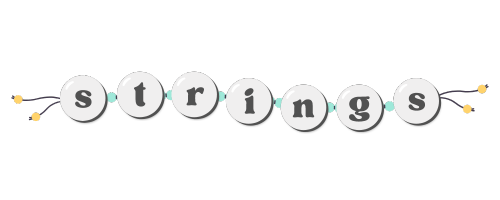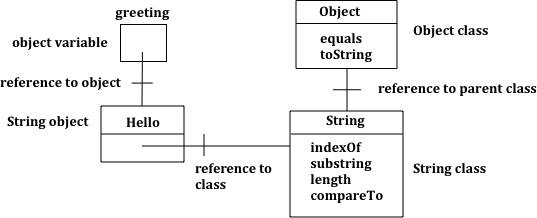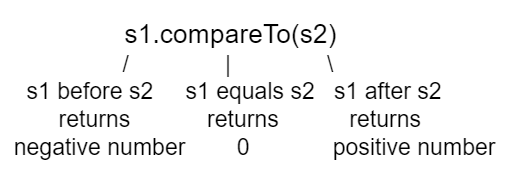📓1.15: String Class
Table of Contents
📖 This page is a condensed version of CSAwesome Topic 1.15
Using the String Class
Strings in Java are objects of the String class that hold text, i.e. sequences of characters (a, B, c, $, etc). You can declare a variable to be of the type String.
Remember that a class (or classification) in Java defines the data that all objects of the class have (the instance variables) and the behaviors, the things that objects know how to do (the methods).

Class names in Java, like String, begin with a CAPITAL letter. All primitive types: int, double, and boolean, begin with a lowercase letter. This is one easy way to tell the difference between primitive types and class types.
Creating String References
In Java there are two ways to create an object of the String class. You can use the new keyword followed by a space and then the class constructor and then in parentheses you can include values used to initialize the fields of the object.
String greeting = new String("Hello World");
This is the standard way to create a
newobject of any class in Java.
In Java you can also use just a string literal, which is a set of characters enclosed in double quotes (" "), to create a String object:
String greeting = "Hello";
In both cases an object of the String class will be created in memory, and the value of the variable greeting will be set to an object reference (👉 a way to find that object).

String Concatenation

Strings can be added together (concatenated) with + or +=:
+combines values to form a newString.+=appends to the existing value (also creates a new String, since Strings are immutable).
Add a last name variable and append it, then add extra exclamation points.
String start = "Happy Birthday";
String name = "Jose";
String result = start + " " + name;
result += "!";
System.out.println(result);
Note that spaces are not added between strings automatically! If you want a space between two strings then add one using + " " +. If you forget to add spaces, you will get smushed output like "HiJose". And remember that variables are never put inside the quotes ("") since this would print the variable name out letter by letter instead of its value.
You can even add other items to a string using the + operator. Primitive values like int and boolean will be converted to a String like what you would type into a Java program and objects will be converted to String using the toString method discussed in the previous section.
💬 Discuss: What do you think the following code will print out?
String message = "12" + 4 + 3;
System.out.println(message);
Since the same operators are processed from left to right this will print
1243. First 4 will be turned into a string and appended to 12 and then 3 will be turned into a string and appended to 124. If you want to do addition instead, try using parentheses!
If you are appending a number to a string it will be converted to a string first before being appended.
String Methods
A string holds characters in a sequence. Each character is at a position, or index, which starts with 0 as shown below. An index is a number associated with a position in a string. The length of a string is the number of characters in it including any spaces or special characters. The string below has a length of 14:

The first character in a String is at index 0 and the last character is at length - 1.
For the AP CSA exam, you only need to know how to use the following String methods. All of the String method descriptions are included in the AP CSA Java Quick Reference Sheet that you get during the exam so you don’t have to memorize these.
| Method | Output |
|---|---|
int length() | Returns the number of characters in the string, including spaces and special characters like punctuation. |
String substring(int from, int to) | Returns a new string with the characters in the current string starting with the character at the from index and ending at the character before the to index (if the to index is specified, and if not specified it will contain the rest of the string). |
int indexOf(String str) | Searches for the string str in the current string and returns the index of the beginning of str in the current string, or returns -1 if it isn’t found. |
int compareTo(String other) | Returns a negative value if the current string is less than the other string alphabetically, 0 if they have the same characters in the same order, and a positive value if the current string is greater than the other string alphabetically. |
boolean equals(String other) | Returns true when the characters in the current string are the same as the ones in the other string. This method is inherited from the Object class, but is overridden which means that the String class has its own version of that method. |
length, substring, indexOf
Test the code below to see the output from the String methods length, substring, and indexOf. The length method returns the number of characters in the string, not the last index (which is length -1). The str.substring(from,to) method returns the substring from the from index up to (but not including) the to index. The method str.indexOf(substring) searches for the substring in str and returns the index of where it finds substring in str or -1 if it is not there.
This code shows the output from String methods length, substring, and indexOf.
💬 Discuss: How many letters does substring(0,3) return? What does indexOf return when its argument is not found?
String message1 = "This is a test";
String message2 = "Hello Class";
System.out.println(message1.length());
System.out.println(message2.length());
System.out.println(message1.substring(0, 3));
System.out.println(message1.substring(2, 3));
System.out.println(message1.substring(5));
System.out.println(message1.indexOf("is")); // This will match the is in "This"!
System.out.println(message1.indexOf("Hello"));
System.out.println(message2.indexOf("Hello"));
// lowercase and uppercase methods are not on the AP exam, but still useful
System.out.println(message2.toLowerCase());
System.out.println(message2.toUpperCase());
Remember that substring(from,to) does not include the character at the to index! To return a single character at index i, use str.substring(index, index + 1).
🐷 Pig Latin: Move the first letter to the end and add "ay".
Write code for a pigLatinWord so that:
"java"→"avajay""pig"→"igpay"
String word = "pig";
// your code here
CompareTo and Equals
We can compare primitive types like int and double using operators like == and < or >, which you will learn about in the next unit. However, with reference types like String, you must use the methods equals and compareTo, not == or < or >.
The method compareTo compares two strings character by character. If they are equal, it returns 0. If the first string is alphabetically ordered before the second string (which is the argument of compareTo), it returns a negative number. And if the first string is alphabetically ordered after the second string, it returns a positive number. (The actual number that it returns does not matter, but it is the distance in the first letter that is different, e.g. A is 7 letters away from H.)

The equals method compares the two strings character by character and returns true or false. Both compareTo and equals are case-sensitive. There are case-insensitive versions of these methods, compareToIgnoreCase and equalsIgnoreCase, which are not on the AP exam.
Test the code below to see the output from compareTo and equals.
String message = "Hello!";
System.out.println(message.compareTo("Hello!"));
System.out.println(message.compareTo("And"));
System.out.println(message.compareTo("Zoo"));
System.out.println(message.equals("Hello!"));
System.out.println(message.equals("hello!"));
Since
"Hello!"would be alphabetically ordered after"And",compareToreturns a positive number. Since"Hello!"would be alphabetically ordered before"Zoo",compareToreturns a negative number. Notice thatequalsis case-sensitive.
Strings are immutable which means that they can’t change after creation. Anything that you do to modify a string (like creating a substring or appending strings) returns a new string.
Common Mistakes with Strings
- Thinking
substringincludes the last index. - Forgetting Strings are immutable.
- Using invalid indices.
- Calling methods on a
nullreference (NullPointerException). - Using
==to compare Strings instead of.equals. - Assuming uppercase and lowercase are equal.
String Methods Game
Try the game below written by AP CSA teacher Chandan Sarkar. Click on Strings and then on the letters that would be the result of the string method calls. We encourage you to work in pairs and see how high a score you can get.
Summary
-
(AP 1.15.A.1) A
Stringobject represents a sequence of characters and can be created by using a string literal. -
(AP 1.15.A.2) The
Stringclass is part of thejava.langpackage. Classes in thejava.langpackage are available by default. -
String objects can be created by using string literals (String s = “hi”;) or by calling the String class constructor (String t = new String(“bye”);).
-
(AP 1.15.A.3) A String object is immutable, meaning once a String object is created, its attributes cannot be changed. Methods called on a String object do not change the content of the String object.
-
(AP 1.15.A.4) Two String objects can be concatenated together or combined using the + or += operator, resulting in a new String object.
-
(AP 1.15.A.4) A primitive value can be concatenated with a String object. This causes the implicit conversion of the primitive value to a String object.
-
(AP 1.15.A.5) A String object can be concatenated with any object, which implicitly calls the object’s
toStringmethod (a behavior which is guaranteed to exist by the inheritance relationship every class has with the Object class). An object’stoStringmethod returns a string value representing the object. Subclasses of Object often override the toString method with class-specific implementation. Method overriding occurs when a public method in a subclass has the same method signature as a public method in the superclass, but the behavior of the method is specific to the subclass. Overriding thetoStringmethod of a class is outside the scope of the AP CSA exam. - index - A number that represents the position of a character in a string. The first character in a string is at index 0.
- length - The number of characters in a string.
-
substring - A new string that contains a copy of part of the original string.
-
(AP 1.15.B.1) A String object has index values from 0 to one less than the length of the string. Attempting to access indices outside this range will result in an
IndexOutOfBoundsException. -
(AP 1.15.B.2) The following String methods and constructors, including what they do and when they are used, are part of the AP CSA Reference Sheet that you can use during the exam: -
String(String str) : Constructs a new String object that represents the same sequence of characters as str.
-
int length() : returns the number of characters in a String object.
-
String substring(int from, int to) : returns the substring beginning at index from and ending at index (to -1).
-
String substring(int from) : returns substring(from, length()).
-
int indexOf(String str) : searches for str in the current string and returns the index of the first occurrence of str; returns -1 if not found.
-
boolean equals(String other) : returns true if this (the calling object) is equal to other; returns false otherwise. Using the equals method to compare one String object with an object of a type other than String is outside the scope of the AP CSA exam.
-
int compareTo(String other) : returns a value < 0 if this is less than other; returns zero if this is equal to other; returns a value > 0 if this is greater than other. Strings are ordered based upon the alphabet.
-
str.substring(index, index + 1)returns a single character at index in stringstr.
Acknowledgement
Content on this page is adapted from Runestone Academy - Barb Ericson, Beryl Hoffman, Peter Seibel.